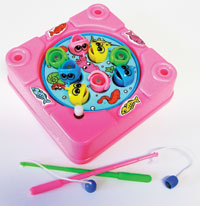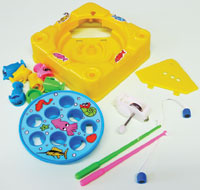|
||||||||||||||||
|
||||||||||||||||
%
responses 2008 ('04) |
||||||||||||||||
y4 |
y8 |
|||||||||||||||
| 1. How are the fish caught on the fishing line? prompt: Can you show me how this works? |
||||||||||||||||
| Explanation involving magnetic attraction: | mentioned magnet on fishing line, metal inside fish mouths |
17 (21) |
21 (30) |
|||||||||||||
reverse of above, or identified both
parts as magnets |
44 (39) |
57 (43) |
||||||||||||||
general idea that a magnet is involved |
30 (32) |
21 (26) |
||||||||||||||
no mention of magnet |
8 (8) |
1 (2) |
||||||||||||||
| Mentioned: | fish are only “caught” when
their mouths are open |
32 (38) |
31 (35) |
|||||||||||||
| 2. How do the fish open and close their mouths? You can use the toy to see
how it works. prompt: Can you show me how this works? |
||||||||||||||||
| Explanation of turntable: [(blue part) rotates/turns, sloping ramps (parts) underneath push fish up.] |
clear explanation |
7 (5) |
20 (17) |
|||||||||||||
vague explanation |
29 (30) |
37 (43) |
||||||||||||||
mentioned ramps but not function |
11 (15) |
11 (13) |
||||||||||||||
no mention of ramps |
54 (50) |
32 (27) |
||||||||||||||
| Mentioned: | when fish are pushed up,
their mouths fall open |
39 (36) |
55 (57) |
|||||||||||||
[Click on graphic to enlarge.] Here is the same toy but it has been taken apart so you can see how it works and how it is made. Hand the student the winder mechanism. 3. Look carefully at the winder. How does the winder make the game work? |
||||||||||||||||
| Explanation of turning the winder
to wind up a motor/spring: |
specific mention of winding up spring (i.e. storing energy in spring) |
4 (8) |
13 (13) |
|||||||||||||
vague idea of winding up motor |
56 (61) |
52 (55) |
||||||||||||||
no relevant comment |
41 (31) |
35 (32) |
||||||||||||||
| Explanation of: |
the spring/motor then making its axle (and/or the associated cogs) turn |
23 (30) |
37 (43) |
|||||||||||||
the large cog alongside the spring making the other cog(s) and/or axle(s) turn |
27 (29) |
44 (38) |
||||||||||||||
the cog on outside of motor connecting
to cog on turntable (making it turn) |
53 (49) |
63 (67) |
||||||||||||||
| 4. Is there anything that could be done to make this a better toy for children? prompt: What could be done? |
||||||||||||||||
| Quality of ideas: |
strong |
12 (15) |
20 (29) |
|||||||||||||
moderate |
44 (36) |
50 (41) |
||||||||||||||
weak |
44 (49) |
30 (31) |
||||||||||||||
| 5. Are there any people this toy might not be suitable for? Why? | ||||||||||||||||
dealt specifically with danger of removable small fish for little children who might put the fish in their mouths |
54 (53) |
68 (74) |
||||||||||||||
| Overall quality of ideas: |
strong |
7 (12) |
12 (17) |
|||||||||||||
moderate |
60 (52) |
56 (61) |
||||||||||||||
weak |
33 (36) |
32 (22) |
||||||||||||||
Total
score: |
13–18 |
4 (9) |
15 (14) |
|||||||||||||
10–12 |
16 (15) |
28 (37) |
||||||||||||||
7–9 |
35 (23) |
30 (28) |
||||||||||||||
4–6 |
30 (39) |
22 (15) |
||||||||||||||
0–3 |
14 (13) |
5 (6) |
||||||||||||||
| Subgroup Analysis [Click on charts to enlarge] : |
| Commentary: |
| Students were moderately successful in explaining the workings of a mechanical game involving magnets, springs, cogs and a motor. Many students, at both years, had good ideas on how to improve the game. Gains from year 4 to year 8 were moderate. There were negligible gender differences. Pakeha students were more successful on the task than Mäori and Pasifika students at year 8. Results were similar to the 2004 results.
|



